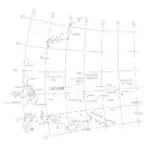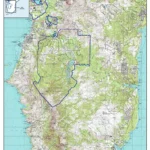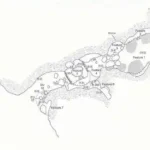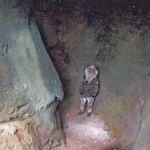Japanese Stragglers on Guam
Table of Contents
Share This
Hiding in the jungle
After the US declared the WWII invasion of Guam to be over on 10 August 1944, two companies of approximately 60 Japanese infantry, each still under military command, were ordered by their officers to conduct guerilla warfare against American forces. These Japanese troops followed smaller groups of stragglers who had already escaped into the rugged interior of the island to avoid combat.
During the following months of WWII, the 3rd Marine Division with CHamoru/Chamorro guides conducted armed reconnaissance through the rugged limestone interior of the island, pursuing Major Sato in the south and Lieutenant Colonel Hideyuki Takeda in what is today the US Naval Ordnance Annex. Japanese infantry and other military stragglers survived on the land by foraging in former Chamorro lanchos and taking what could be of use from US military surplus dumps.
Only after the Emperor of Japan broadcast his surrender order did Takeda and his troops lay down their arms on 4 September 1945. By that time, over 1,200 Japanese troops on the island had surrendered, many in response to American broadcasts by bullhorn and aerial distribution of leaflets in Japanese.
Stragglers continued to hide in the jungles for decades, however, with Chamorro fishermen capturing the last Japanese soldier of WWII in Talo’fo’fo in 1972.
Recent archaeological surveys of the US Naval Ordnance Annex revealed evidence of the occupation of limestone rock shelters and caverns by Japanese infantry and/or stragglers, who often found and used or modified American items for their daily survival.
Shelters, items found at Fena
In 1998 an archaeological survey was conducted in several areas northwest of Fena Reservoir within the present day US Naval Ordnance Annex. Archaeologists found a rock shelter containing a metal storage tube top, copper screening, a brass button, and a nontraditional ceramic sherd.
Another rock shelter revealed the remains of a WWII era US ordnance canister and lid, metal saw blade fragments, segments of rubber tire with hand-drilled holes, bailing wire, a clear glass jar, fragments of sheet metal, and small bits of paper printed with Japanese characters adhered to a Tridacna shell.
Another set of small caves nearby contained three US ordnance canisters, a leather shoe sole impressed with “Danbury”, a military helmet fragment, a broken cooking pot, wire mesh, and a brown glass bottle with embossed “K” on its base. Mounded limestone rock piles and crude walls on the surface at all three locations suggested modification for use as a shelter during or after the US invasion.
In 2002 a second archaeological survey of the US Naval Ordnance Annex northeast of Fena Reservoir was conducted in an area of deep limestone sinkholes and interconnected marshes with high narrow ridges containing shallow rock shelters and caves above the fabled Lost River.
Three natural caves were modified by low rock walls around their entrance for defense, with low platforms to provide sleeping quarters and cooking areas. Smaller rock shelters may have been used as lookout points for Japanese stragglers observing American and Chamorro patrols. It is assumed that dense native vegetation was left in front of both site types to obscure their entrance and use.
Materials left behind by WWII Japanese infantry and stragglers were mostly of American manufacture or Japanese modification and consisted of clothing (such as leather shoes, rubber tire sandals, and metal uniform buttons), glass bottles (of medicine, condiments, beer, sake, and liquor), Japanese cooking gear (metal woks), US military cooking gear (metal pots, bowls, mess kits, and utensils), tools (such as headlamps, pickaxes, clearing axes, and trenching tools), US military shelters (such as tarps and their storage tubes), personal items (such as shaving cream, toothbrushes, and pencils), cloth fabrics (such as burlap bags), and weapon related supplies (such as bullet casings, clips, and ammunition boxes).
Several of these refuge sites contained evidence of WWII-era fire pits or cobble hearths, presumably used for cooking at night to avoid detection. Animal remains were also present in some of these caves and rock shelters, indicating that Japanese infantry and stragglers were trapping or hunting pigs and deer.
Guam Combat Patrol's role
The fact that Japanese stragglers were still living on Guam after WWII did not go unnoticed by the American military administration or the Japanese foreign office. A volunteer corps of armed Chamorro civilians called the Guam Combat Patrol led by Police Staff Sergeant Juan U. Aguon, was formed in 1945 to ferret out just such stragglers with US Marine assistance. The Chamorros, having survived the Japanese occupation of Guam for two and a half years, had personal reasons for taking no captives in pursuance of their duties.
The Guam Combat Patrol were considered “manhunters” killing at least 117 Japanese stragglers, and capturing five. Two members were killed in action – Antonio P. Manibusan and Pedro R. San Nicolas. Two others, Juan L. Lujan, and Vicente L. Borja, were wounded.
Small groups of stragglers stayed mobile and tried to avoid leaving evidence of their passing, but hunger and quiet desperation sometimes drove them to take risks.
In 1953, nine years after the war had ended, Operation Straggler was launched in southern Guam by the US military with Japanese assistance; packages were left in caves, posters were nailed to trees, and a Navy plane dropped fifteen thousand leaflets. Nobody was found however, nor did anyone surrender.
In 1957, some off-duty Marines on a boonie stomp found a campsite with cooking gear and hand tools. Naval Intelligence then posted on-duty Marine patrols in the area who found sleeping pads made of palm fronds, Japanese tabi or slit-toed socks, chopsticks, a toothbrush with Japanese Navy emblem, hack saw blades, files, a saw, cooking pots and pot holders, a pestle, a jar of oil, a glass bottle, and a crude two-wheeled cart.
A few months later, a woman noticed a scrawny long haired person disappearing into the rough at the Windward Hills Golf and Country Club, two miles east of the Navy Magazine. It was not until 1960, however, that two Chamorro hunters near the golf course captured one of these stragglers named Minagawa, and with his help his companion Ito later surrendered.
According to these captives, most stragglers maintained the rudiments of military order, but personal differences remained, especially in the face of deteriorating health and obvious evidence that the war had not fared well for the Japanese. Savvy stragglers avoided smoking American cigarette butts, burning fires during daylight, or stripping trees of their fruit for fear of giving away their position.
The stragglers told of eating roots, frogs, and snails, since the hunt for sustenance was a daily event. Besides foraging, Minagawa and Ito visited a US Army dump every week, filling their homemade knapsacks with empty cans and bottles, broken shovels and eating utensils, yards of mosquito netting, rags to patch their clothes with or to unravel for thread, bedsprings to convert into sewing needles, and empty cartridge cases to use as thimbles.
In 1972, two Chamorro hunters, Jesus Duenas and Manny DeGracia, captured the final Japanese straggler, Sergeant Shoichi Yokoi, while he was setting shrimp traps approximately five miles inland from Talo’fo’fo, just southeast of the US Naval Ordnance Annex.
Yokoi fashioned his own clothing from the bark of the Pago tree. His hand-dug refuge tunnel was found to have traps he built to catch rats for consumption, to supplement his diet of boiled Federico palm nuts, shrimp, and fish which he cooked underground. Today a recreation of this tunnel is a tourist attraction visited by many tourists on Guam.
The US Navy keeps the archaeological sites at Fena protected.
Editor’s note: Fieldwork noted in this entry was performed by the following companies contracted by the US Navy:
- 1998, Ogden Environmental and Energy Services, Inc. (OEES)
- 2002, Pacific Consulting Services, Inc. (formerly OEES)
For further reading
Aguon, Tina D. “Combat Patrol Hunts for Stragglers.” War in the Pacific NHP: Liberation – Guam Remembers, last modified 12 June 2014.
Denfeld, D. Colt. Hold the Marianas: The Japanese Defense of the Mariana Islands. Shippensburg: White
Mane Publishing, 1981.
Gailey, Harry. The Liberation of Guam, 21 July-10 August 1944. Novato: Presidio, 1988.
Jones, Don. Oba, The Last Samurai: Saipan 1944-1945. Novato: Presidio Press, 1986.
Kahn, Ely Jacques. The Stragglers. New York: Random House, 1962.
Lodge, Orlan Robert. The Recapture of Guam. Washington, DC: Historical Branch, G-3 Division
Headquarters, US Marine Corps, 1954.
Peattie, Mark R. Nan`yo: The Rise and Fall of the Japanese in Micronesia, 1885-1945. Honolulu: University of Hawai’i Press, 1988.




